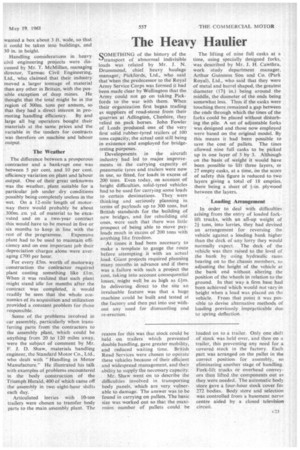The Heavy Haulier
Page 61

If you've noticed an error in this article please click here to report it so we can fix it.
SOMETHING of the history of the "transport of abnormal indivisible loads was related by Mr. J. N. Drummond, chief heavy haulage manager, Pickfords, Ltd., who said that when the predecessor to the Royal Army Service Corps was formed it had been made clear by Wellington that the 'Army could not go on taking Pickfords to the war with them. When their organization first began trading as suppliers of road-stone from their quarries at Adlington, Cheshire, they relied on pack horses. John Fowler of Leeds produced one of the very First solid rubber-tyred trailers of 100 tons capacity, the actual unit still being in existence and employed for bridgetesting purposes.
Developments in the aircraft industry had led to major improvements in the carrying capacity of pneumatic tyres and trailers were now in use, so fitted, for loads in excess of 200 tons. Even today, on account of height difficulties, solid-tyred vehicles had to be used for carrying some loads to certain destinations. They were thinking and seriously planning in terms of payloads up to 300 tons, but British standards for the building of new bridges, and for rebuilding old ones, were such that there was little prospect of being able to move payloads much in excess of 200 tons with anything like freedom.
At times it had been necessary to make a template to gauge the route before attempting it with an actual load. Giant projects required planning many months in advance and if there was a failure with such a project the cost, taking into account consequential losses, might well be as high as Lim. In delivering direct to the site an invaluable feature was that a huge machine could be built and tested at the factory and then put into use without any need for dismantling and re-erection. The lifting of nine full casks at a time, using specially designed forks, was described by Mr. J. H. Cawthra, work study department manager, Arthur Guinness Son and Co. (Park Royal), Ltd., who said that they were of metal and barrel shaped, the greatest diameter (17f in.) being around the middle, the diameter of the ends being somewhat less. Thus if the casks were touching there remained a gap between the ends through which the tines of the forks could be placed without disturbing the pile. A set of adjustable forks was designed and those now employed were based on the original model. By this means it had been possible to save the cost of pallets. The tines allowed nine full casks to be picked up in one layer of 3 by 3. Although on the basis of weight it would have been possible to lift three layers, or 27 empty casks, at a time, on the score of safety this figure is reduced to two layers giving a total of 18 empties, there being a sheet of +-in. plywood between the layers.
Loading Arrangement In order to deal with difficulties arising from the entry of loaded forklift trucks, with an an-up weight of 21 tons, into lorries, they had devised an arrangement for reversing the vehicle against a loading bank higher than the deck of ,any lorry they would normally expect. The deck of the vehicle was then raised to the level of the bank by using hydraulic rams bearing on to the chassis members, so adjusting the height of the vehicle at the bank end without altering the position of the wheels in relation to the ground. In that way a firm base had been achieved which would not vary in height when a load was placed on the vehicle. From that point it was possible to devise alternative methods of loading previously impracticable due to spring deflection.




























































































































